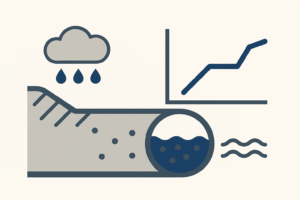Dirt load calculation
What is dirt load calculation?
Pollutant load calculation is a method for the quantitative determination of pollutant inputs into water bodies via drainage systems, particularly in the field of urban water management. It is used to evaluate, plan and optimize wastewater systems, taking hydrological, hydraulic and material aspects into account.

Goal and significance
The aim of the pollutant load calculation is to estimate the load of pollutants such as organic substances, nitrogen compounds, phosphates or heavy metals in receiving waters – i.e. natural bodies of water. This pollution occurs primarily in rainy weather when rainwater and wastewater are discharged together in combined sewer systems and can enter the environment via discharge structures. The results of the pollutant load calculation are the basis for:
-
the design and dimensioning of rainwater treatment systems,
-
the fulfillment of water law requirements,
-
the ecological assessment of water pollution,
-
and the strategic planning of measures to relieve water pollution.
Areas of application
The dirt load calculation is used in various contexts:
-
New construction or renovation projects in the sewerage sector
-
Review of permits under water law
-
Creation of general drainage plans
-
Model-based variant comparisons in the development of measures
-
Verification in accordance with DWA regulations (e.g. DWA-A 128, DWA-M 153)
Methodology
The calculation is usually model-based on the basis of extensive input data such as:
-
Rainy season series
-
Discharge behavior of the sewer network
-
Pollution levels in the catchment areas
-
Hydraulic properties of structures and pipelines
Both dry weather and rainwater runoff are considered. The differentiation between mixed and separation systems plays a central role here. The simulation can be based on individual events or long-term series in order to make statements about the average annual load or the load during extreme events.
Software and models
Special simulation tools that model hydraulic, hydrological and material processes in drainage systems are used to calculate pollution loads. The aim is to make realistic statements about the quantity and composition of the discharged material loads under different meteorological and operational conditions.
A widely used model in Germany is SMUSI (Pollutant Load Simulation Model for Combined and Separation Systems), which was developed by the Hessian State Agency for Nature Conservation, Environment and Geology (HLNUG). It is used for the standardized determination of pollution load parameters on the basis of long-term rainfall time series and is used in particular for the design and evaluation of rainwater treatment plants.
There are also other software solutions, such as:
HYSTEM-EXTRAN: A hydrodynamic model for the calculation of discharges and loads in sewer networks.
InfoWorks ICM: An integrated platform for modeling sewers, water bodies and wastewater treatment plants.
KOSIM: A simplified long-term simulation model for the design of stormwater treatment systems.
The choice of a suitable model depends on various factors – including the objective of the calculation, the available data basis, the official requirements and the complexity of the drainage system. While some models rely on detailed hydrodynamic simulations, others use statically simplified approaches with empirical parameters.
A reliable pollution load calculation always requires well-founded input data, professional model calibration and a comprehensible evaluation of the results. The software serves as a tool for systematic analysis – the actual evaluation, however, requires engineering expertise and experience in dealing with complex drainage systems.
Focus SMUSI
The SMUSI model depicts both hydraulic and material processes in mixing and separation systems. It takes into account long-term rainfall time series, catchment area characteristics, degree of pollution, retention volumes as well as relief and treatment structures. SMUSI enables the detailed simulation of stormwater runoff, retention effects and discharges into receiving waters or wastewater treatment plants.
A key objective is to assess compliance with the requirements of the DWA regulations, in particular worksheets DWA-A 102 and A 128, with regard to water pollution from combined and stormwater runoff. Among other things, the average annual loads, discharge frequencies and volumes are determined.
The application is based on a standardized workflow and in a coordinated software environment (including hydrodynamic sewer network models and precipitation data). The results serve as the basis for expert reports, evaluations of measures, comparisons of variants and approval documents.
SMUSI has proven to be an established tool in Hesse and is increasingly being used as a reference model in other federal states. It supports transparent and comprehensible decision-making and makes a significant contribution to the sustainable design of urban drainage and the protection of water bodies.
Challenges
The quality of the results of the pollutant load simulation depends heavily on the accuracy of the input data, the calibration of the models and the selection of suitable design criteria. In addition, the representation of real conditions (e.g. backwater, throttling effects, catchment area dynamics) is complex in terms of model technology and requires sound specialist knowledge.
Link to the article by Stadtentwässerung Stuttgart

